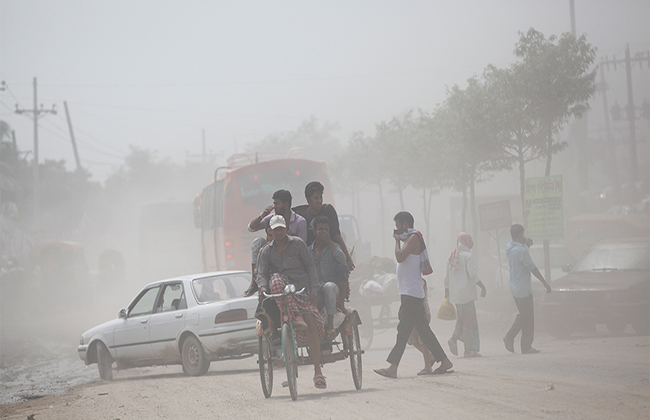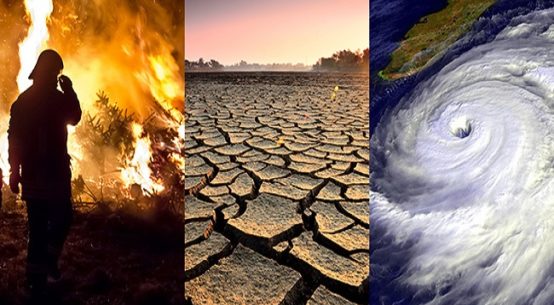
Air pollution in Bangladesh is the worst in the world, contributing to a reduction of nearly seven years in the average life expectancy, according to a new study.
In the most polluted areas of the country, life expectancy is reduced by 8.1 years, according to the Air Quality Life Index (AQLI) study conducted by the Energy Policy Institute at the University of Chicago, which also ranked Bangladesh as the country with the world’s worst air pollution every year since 2018.
Air pollution levels here exceed both national and global standards, and have gotten worse over the past two and a half decades.
“All of Bangladesh’s 161 million people live in areas where the annual average particulate pollution level exceeds both the WHO [World Health Organization] guideline and the country’s own national standard,” the study says, adding that, “Since 1998, the country’s average annual particulate pollution has increased by 39 percent, reducing the average life expectancy of a Bangladeshi citizen by 2.1 years.”
This effectively makes pollution one of the biggest killers of Bangladeshi people.
“The impact of particulate pollution is greater than the effects of devastating communicable diseases like tuberculosis and HIV/AIDS, behavioral killers like cigarette smoking, and even war,” the study says.
Worldwide, 3.8 million people die every year because of household exposure to smoke from dirty cooking stoves and fuels, while outdoor air pollution is responsible for 4.2 million deaths annually, according to the WHO.
Nine out of 10 people worldwide live in places where air quality exceeds WHO guideline limits. In Bangladesh, according to the AQLI, particulate pollution levels are at least four times the WHO guideline in every one of its 64 districts.
In the regions of Dhaka and Khulna Division, which include the country’s biggest and third-biggest cities, the pollution level is more than eight times the WHO limit, reducing the life expectancy of the people living in those areas by about eight years compared to if the WHO guideline was met.
In the second-largest city, Chattogram, previously known as Chittagong, residents lose 4.8 years of their lives, even though the air quality there is better than the national average.
“The situation is becoming more complicated day by day,” said Abdus Salam, a professor of chemistry at the University of Dhaka who studies air pollution. “We have been pressing the government to take action for a long time, but so far, little has been done to reduce pollution.”
The most polluted country in the world
Bangladesh and its capital, Dhaka, have hit the headlines on numerous occasions in recent years for being one of the most polluted places on Earth. In 2018, IQAir, a Swiss-based air quality technology company, ranked Bangladesh as the most polluted country on Earth.
The WHO’s recommended safe limit for particulate matter — known as PM2.5, a mixture of solid particles and liquid droplets found in the air — is 5 micrograms per cubic meter (µg/m3).
According to the IQAir 2021 World Air Quality Report, Bangladesh’s average concentration of PM2.5 was 76.9 µg/m3, which is 15 times above the WHO guideline. Dhaka, with an annual average PM2.5 concentration of 78.1 µg/m, was ranked the second most polluted regional capital city in the world, behind only New Delhi in neighboring India.
Afroza Akter, a mother of three in the Uttara region of Dhaka, said she lives and breathes through this poisonous air every morning as she drops her children to school.
“On some days, you can barely see anything because of the dust kicked up by construction sites all around,” she said. “They don’t take any precautions, no one seems to be enforcing any rules and no one is ever punished for endangering people’s lives like this.”
The authorities have acknowledged the severity of the problem, but have so far done little to rectify the situation.
“We have issues with air quality in Bangladesh. There is excessive dust pollution and particulate pollution in Dhaka’s air,” said Md. Ziaul Haque, director of the Department of Environment. “We are trying to keep things at a tolerant level with different initiatives, especially during dry season.”
24,000 premature deaths in Dhaka from 2005-2018
A study published in April in Science Advances estimated there were 24,000 premature deaths in Dhaka between 2005 and 2018 due to air pollution. That was the highest among 46 cities studied.
Among the top of 15 most polluted cities in the world, most of them in Asia, Dhaka has seen the largest increase in the number of premature deaths.
Cars, trucks and buses, power plants, and off-road equipment emit nitrogen dioxide, the second-deadliest pollutant, according to the WHO. NO2 emissions tripled in Chattogram and doubled in Dhaka during the study period. Emissions of another pollutant, non-methane volatile organic compounds (NMVOCs), also increased in both cities.
“If the future mimics the past, then the transition to sensitivity to NMVOCs could occur as soon as 2025 in Chittagong and Dhaka,” the study says.
Haque from the Department of Environment agreed that vehicle emissions, industrial dust, open waste burning, large-scale construction activities, and, most importantly, brick-burning kilns are the key contributors to air pollution.
“The government has taken initiatives to take down conventional brick kilns and issued a notification for the use of concrete blocks, instead of conventional bricks, in government projects. By 2025, the government will use concrete blocks on a mandatory basis in all sectors, except for in road construction,” he said.
Haque added the situation should improve in the coming years once construction of various mega projects is completed by next year.
Draft Clean Air Act gathers dust
Four years have passed since the draft Clean Air Act of 2019 was completed, but the government has still not turned it into law.
In its 2016-2020 five-year plan, the government calls for enacting the law to improve air quality in Dhaka and other large cities, but now the act is being implemented piecemeal, in rules.
Syeda Rizwana Hasan, chief executive of the Bangladesh Environmental Lawyers Association (BELA), an organization that was involved in drafting the act, said that if the draft was enacted, then air pollution would get more institutional attention.
“We could then have coordinated effort from all government offices, departments, and agencies to curb pollution. Not all government wings will give the issue enough importance if it is just converted to rules,” she said.
“Almost all neighboring countries have an act to tackle air pollution,” she added.
But chemistry professor Salam said a law alone won’t be enough to solve the problem.
“It is very unfortunate that the act has been gathering dust for several years. But just a law is not sufficient. There are many things written in a law, but what you really need is ensuring implementation of the law,” he said.
“At the same time, it requires years of collective initiatives from both the government and private sector,” he added.
Experts also emphasized the importance of education to improve air quality in Bangladesh. The general population of the country should be informed about the disastrous effects of pollution so they can reconsider the materials they burn for daily use.
(This article is republished from Mongabay under Creative Commons License)
Mahadi Al Hasnat is a Press & Media Coordinator for the U.S. Embassy in Dhaka.

